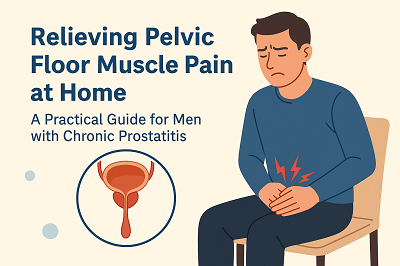Relieving Pelvic Floor Muscle Pain from Chronic Prostatitis at Home
Living with chronic prostatitis can be frustrating, especially when it leads to deep, persistent pelvic floor pain. This kind of discomfort often radiates to the lower abdomen, perineum, or groin, and may worsen when sitting, after urination, or even during stress. While medical treatment is important, many patients ask: "What can I do at home to ease the pain?"

This article explores practical, evidence-based methods to manage pelvic floor muscle pain caused by chronic prostatitis from the comfort of your home.
Why Does Chronic Prostatitis Cause Pelvic Floor Pain?
Chronic prostatitis, especially the chronic pelvic pain syndrome (CPPS) type, isn't always due to infection. Often, it is linked to pelvic floor muscle dysfunction. When these deep muscles are overly tight, inflamed, or fatigued, they can cause persistent pain that mimics prostate inflammation. Stress, prolonged sitting, poor posture, or anxiety can all contribute to this cycle of muscular tension and pain.
Home Remedies to Soothe Pelvic Floor Pain
1. Pelvic Floor Relaxation Exercises
Try diaphragmatic breathing and pelvic drops (not Kegels). The goal here is to relax, not contract, the pelvic floor.
How to try it:
- Lie on your back with knees bent.
- Inhale deeply into your belly (not your chest).
- On exhale, consciously relax the muscles around your anus, perineum, and lower abdomen.
- Repeat for 10 minutes daily.
This helps retrain the muscles to remain calm and improve blood flow in the pelvic area.
2. Warm Sitz Baths
Soaking your lower body in a warm bath can ease tension, reduce inflammation, and improve circulation.
Instructions:
- Use a sitz bath basin or a clean bathtub.
- Fill with warm water (not hot).
- Sit in the water for 15–20 minutes, once or twice a day.
Optional: Add Epsom salt or a few drops of chamomile oil for added relaxation.
3. Gentle Stretches and Yoga Poses
Incorporate stretches like the child’s pose, happy baby, or reclining butterfly. These poses naturally open the pelvic floor and help relieve tightness.
Practicing yoga can also reduce stress, which is often a trigger for chronic pelvic pain flares.
4. Lifestyle Adjustments
Certain lifestyle changes can reduce pelvic floor irritation and support pain relief:
Hydration and Diet: Stay hydrated and avoid bladder irritants like caffeine, alcohol, spicy foods, and acidic foods, which can worsen symptoms. Incorporate anti-inflammatory foods such as berries, leafy greens, and omega-3-rich fish to support overall health.
Posture and Sitting: Prolonged sitting can aggravate pelvic pain. Use a cushioned seat or a donut-shaped pillow to reduce pressure on the pelvic floor. Take breaks every 30–60 minutes to stand, stretch, or walk.
Regular Movement: Low-impact exercises like walking, swimming, or gentle cycling can improve blood flow and prevent muscle stiffness. Aim for 20–30 minutes of activity most days of the week.
5. Stress Management
Stress and anxiety can worsen pelvic floor tension and pain. Incorporate stress-reducing practices into your routine:
Meditation and Mindfulness: Spend 10–15 minutes daily practicing mindfulness or guided meditation to calm your nervous system. Apps or online videos can provide beginner-friendly sessions.
Journaling: Write about your symptoms, emotions, or daily experiences to process stress and identify triggers for your pain.
Sleep Hygiene: Poor sleep can heighten pain perception. Maintain a consistent sleep schedule, limit screen time before bed, and create a relaxing bedroom environment.
Consider Herbal Remedies: Diuretic and Anti-inflammatory Pill
Chronic pelvic pain often involves inflammation that conventional antibiotics may not resolve, especially when there's no infection present.
The Diuretic and Anti-inflammatory Pill is a time-tested herbal formulation based on Traditional Chinese Medicine. It helps by:
- Reducing inflammation in the prostate and surrounding tissues
- Promoting better urination flow and relieving pressure
- Improving microcirculation and soothing pelvic congestion
- Addressing the root cause of prostatitis-related pain
Many patients with nonbacterial prostatitis and pelvic muscle dysfunction report significant symptom relief after using this formula consistently for 1–3 months.
When to Seek Professional Help
While home care can offer noticeable relief, seek medical attention if:
- Pain worsens or spreads
- You develop fever, chills, or blood in the urine
- Urinary symptoms severely impact your quality of life
A pelvic floor physical therapist can also provide targeted treatments and teach advanced muscle release techniques.
Tips for Long-Term Management
Track Symptoms: Keep a symptom diary to identify patterns or triggers, which can help tailor your at-home strategies.
Stay Consistent: Regular practice of relaxation techniques and lifestyle changes is key to sustained relief.
Educate Yourself: Learn about chronic prostatitis and pelvic floor health through reputable sources to feel empowered in managing your condition.
Final Thoughts
Pelvic floor muscle pain due to chronic prostatitis doesn't have to control your life. By combining gentle movement, heat therapy, relaxation techniques, and herbal support like the Diuretic and Anti-inflammatory Pill, you can take control of your symptoms and improve your daily comfort—right from home.
Take a proactive approach, listen to your body, and support it with natural, safe methods. Relief is possible—even without invasive procedures or long-term medications.



